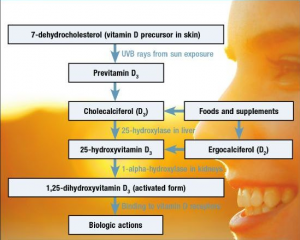
Vitamin D is a fat-soluble vitamin. This Vitamin is produced by our bodies from cholesterol via process that is activated by action of ultraviolet B rays from the sun on our skin. The following factors are taken into consideration when figuring out how much of Vitamin is our body producing: skin color, age, amount and time sun exposure, and geographic location. This important vitamin can play an important role in influences of control of cell cycles, brain, muscles, pancreas, cardiovascular and immune system, intestines and bones. Its primary functions are to maintain normal blood concentration of phosphorus and calcium and to support bone health.
Forms of Vitamin D Cholecalciferol (vitamin D3)

There are two types of vitamin D. Calcitriol (1,25-dihydroxyvitamin D3) with half life of 15 hours and Calcidiol (25-hydroxyvitamin D3) with half life of 15 days.Naturally occurring form of vitamin D; made by the skin upon sun exposure; found in foods and most supplements Calcidiol (25-hydroxyvitamin D3) Prehormone made directly from cholecalciferol in the liver; low biologic activity, but major form circulating in the bloodstream; concentrations measured by typical blood test for vitamin D deficiency Calcitriol (1,25-dihydroxyvitamin D3) Activated form made from calcidiol in the kidneys and tissues; the most potent steroid hormone in the body Ergocalciferol (vitamin D2) Made in the laboratory by radiating fungus; not naturally occurring in the body; used in prescription vitamin D (Drisdol), available in 50,000-IU capsules
Deficiency, Blood Concentrations, and Toxicity
People who live in northern parts of the world where sun exposure is limited are at risk. Failure to get at least 15 minutes a day of direct sun light, being dark skinned, olderly or overweight is a risk factor as well. Conditions such as rickets or osteomalacia, musculoskeletal and periodontal pain are associated with severe vitamin D deficiency. Conditions such as loss of appetite, diarrhea, insomnia, vision problems, and burning sensation in a mouth or throat are signs of mild deficiency of vitamin D. Specific blood test needs to be done in order to detect the level of this vitamin in the body.
Disease Prevention Cancer
Vitamin D decreases cell proliferation and increases cell differentiation, stops the growth of new blood vessels, and has significant anti-inflammatory effects. Many studies have suggested a link between low vitamin D levels and an increased risk of cancer, with the strongest evidence for colorectal cancer.
Heart Disease
Several studies are providing evidence that the protective effect of vitamin D on the heart could be via the renin-angiotensin hormone system, through the suppression of inflammation, or directly on the cells of the heart and blood-vessel walls..
Fractures and Falls
Vitamin D is known to help the body absorb calcium, and it plays a role in bone health. Also, vitamin D receptors are located on the fast-twitch muscle fibers, which are the first to respond in a fall. It is theorized that vitamin D may increase muscle strength, thereby preventing falls. Many studies have shown an association between low vitamin D concentrations and an increased risk of fractures and falls in older adults.
Autoimmune Diseases and Influenza
Since vitamin D has a role in regulating the immune system and a strong anti-inflammatory effect, it has been theorized that vitamin D deficiency could contribute to autoimmune diseases such as multiple sclerosis (MS), type 1 diabetes, rheumatoid arthritis, and autoimmune thyroid disease. Scientists have suggested that vitamin D deficiency in the winter months may be the seasonal stimulus that triggers influenza outbreaks in the winter. Numerous trials have evaluated the association between vitamin D and immune-system diseases.
Type 2 Diabetes and Depression
Some studies have shown that vitamin D may lower the risk of type 2 diabetes, but few studies have examined the effect of vitamin D on depression. A trial of nondiabetic patients aged 65 years and older found that those who received 700 IU of vitamin D (plus calcium) had a smaller rise in fasting plasma glucose over 3 years versus those who received placebo. A Norwegian trial of overweight subjects showed that those receiving a high dose of vitamin D (20,000 or 40,000 IU weekly) had a significant improvement in depressive symptom scale scores after 1 year versus those receiving placebo. These results need to be replicated in order to determine a correlation between vitamin D and the risk of diabetes or depression.
Dosing
Only a few foods are a good source of vitamin D. These include fortified dairy products and breakfast cereals, fatty fish, beef liver, and egg yolks. Besides increasing sun exposure, the best way to get additional vitamin D is through supplementation. Traditional multivitamins contain about 400 IU of vitamin D, but many multivitamins now contain 800 to 1,000 IU. A variety of options are available for individual vitamin D supplements, including capsules, chewable tablets, liquids, and drops. Cod liver oil is a good source of vitamin D, but in large doses there is a risk of vitamin A toxicity.
Since vitamin D is fat soluble, it should be taken with a snack or meal containing fat. In general, 100 IU of vitamin D daily can raise blood concentrations 1 ng/mL after 2 to 3 months Once the desired blood concentration is achieved, most people can maintain it with 800 to 1,000 IU of vitamin D daily. Even though dosages up to 10,000 IU daily do not cause toxicity, it generally is not recommended to take more than 2,000 IU daily in supplement form without the advice of a health care provider. Individuals at high risk for deficiency should have a vitamin D blood test first; a dosage of up to 3,000 to 4,000 IU may be required to restore blood concentrations.
Drug Interactions
Vitamin D supplements may interact with several types of medications. Corticosteroids can reduce calcium absorption, which results in impaired vitamin D metabolism.
Conclusion
As the number of people with vitamin D deficiency continues to increase, the importance of this hormone in overall health and the prevention of chronic diseases is at the forefront of research. The best evidence for the possible role of vitamin D in protecting against cancer comes from colorectal cancer studies. Evidence also is strong for the potential role of vitamin D in preventing fractures and falls. At this time, further studies are needed to evaluate the role of vitamin D in protecting against heart disease, autoimmune diseases, influenza, diabetes, and depression.
This Post was based on information from US Pharmacist.
Post a comment below or share your thoughts through Facebook, Twitter or comment section below to join the conversation.